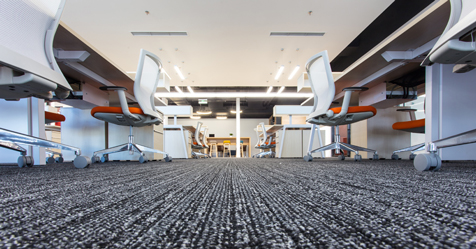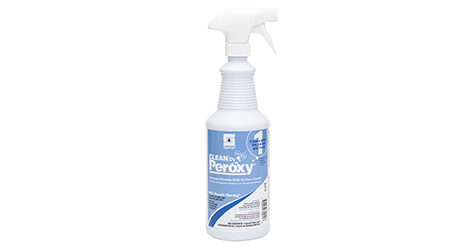Most of us cringe when we see the word chemistry; we either avoided the subject completely in school, or have not-so-fond memories from class of trying to understand what a double bond is and why it’s important. But a basic understanding of the pH of cleaners, along with the chemicals used and how they actually work, will go a long way in selecting the best products to clean and protect carpets and flooring.
Liquid carpet cleaner formulations vary by type and manufacturer, but most water-based cleaners contain a few common ingredients. Surfactants lower the surface tension, enabling the cleaner to spread (wet out) over the carpet fibers and more effectively remove soils. Common surfactants listed on the cleaner’s label may include sulfate, sulfonate, or ethoxylated alcohol. Solvents dissolve soils and stains and help solubilize the other ingredients in the formulation to maintain a stable solution. These can be identified on the label under such terms as glycol ether, isopropanol, or ester. Builders, sometimes known as chelating or sequestering agents, boost cleaning effectiveness by softening the water to prevent hard water ions from interfering with the function of the surfactants. Common builders may include sodium hydroxide, sodium citrate, sodium silicate, sodium phosphate, or ethylene diamine tetraacetic acid. Other ingredients may include anti-redeposition agents, which get deposited on the carpet fiber after cleaning to reduce attraction of soils to the fiber surface. Enzymes are the catalysts behind removing and changing the physical properties in most protein related stains andodors. Bases react with the oil and fat components of soil and make them water miscible.
The Importance of pH
While the actual ingredients are very important, understanding the role pH plays may arguably be the most important factor determining the overall performance and safety of the carpet cleaner.
pH is a figure expressing the acidity or alkalinity of a solution on a logarithmic scale. The pH scale goes from 0 – 14, with 7 being considered neutral. From 0 up to 7 is considered acidic; from just above 7 up to 14 is considered alkaline. From a practical standpoint, products are considered to be more acid or alkaline the further away from 7 the pH gets. The more acidic or alkaline a product is can help to determine how reactive it is to soils, surfaces, skin, and eyes.
Traditionally, alkaline cleaners with a pH of 10 and above have been preferred due to their effectiveness on heavily soiled carpets. At these higher pH levels, an actual chemical reaction known as saponification occurs; organic fats and oils in the soils are converted into a soap when mixed with free alkali (bases) in the cleaners. Common bases used in cleaning products include caustic soda, lye, and sodium silicate. While effective at removing oil based soils from the carpet, high pH cleaners are more corrosive and may damage sensitive fibers and dyes. Most of us can relate to inadvertently using an alkaline cleaner where it shouldn’t be and having to deal with the resulting damage and replacement cost.
The Lesser Impact of Neutral pH
Cleaning products formulated at more neutral pH levels are considered safer for surfaces, people, and the environment compared to those that are extremely acidic or extremely alkaline. The human safety advantages of neutral pH cleaners include a lower potential for oral, dermal, and inhalation toxicity as well as a lower potential for aquatic harm when released into the environment. While safer, more neutral pH cleaners have typically been limited to use in light duty cleaners or for sensitive fibers such as wool and silk, as the cleaning performance was in general not as effective as their alkaline or acidic alternatives. However, recent innovations in surfactants and solvents have enabled a new generation of neutral cleaners that can provide exceptional soil removal while being gentle on fibers and safer for users.
The chemistry and mechanism of cleaning at neutral pH is very different from that of high pH alkaline formulations. Instead of a harsh chemical reaction, neutral cleaners rely on the action of the solvents and/or surfactants to penetrate through and dissolve the soil. The low surface energy of the formulation helps break the adhesive bond that holds the soil to the fiber. The soils are then lifted and dispersed into the cleaning solution, which can be easily rinsed away. And unlike alkaline cleaners, neutral cleaners may not require the use of a neutralizer, or acid rinse, to bring the solution back to neutral pH after cleaning.
Another benefit of some of the newer neutral-pH cleaners is their ability to clean a wider variety of soils. Alkaline cleaners are known to work best when the soil can be hydrolyzed, such as kitchen grease containing natural oils and fats, natural greases, body oils and some proteins. However, they are not very effective on hard water stains, rust, and other more alkaline soils—these typically require a more acidic cleaner. The new innovations in solvents now enable cleaning products to be formulated at neutral pH that can dissolve soils across the spectrum—from greases to soap scum—with one cleaner.
In summary, it is important to understand both the ingredients and the pH of your cleaners, as well as the surfaces and fibers, to make the best selection for your particular cleaning challenge. Consider trying the new neutral pH cleaners on the market. They are gentler on your carpets, safer for use by the cleaning staff, and may even save you time and money through less rinsing and more efficient soil removal.


